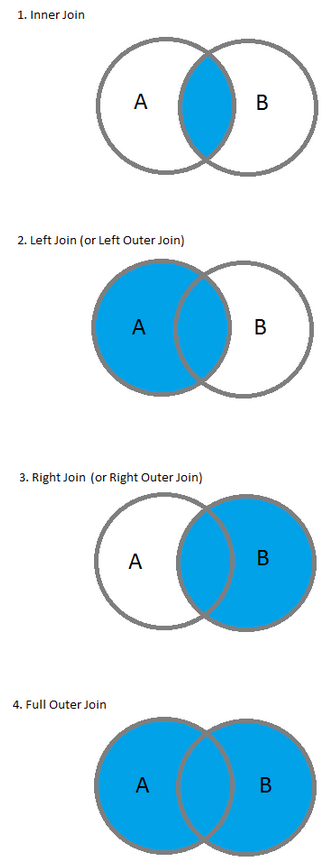MySQL Tutorial: Table Joins (Inner, Left, Right, and Outer Joins) - 2015

A SQL join clause combines records from two or more tables in a relational database. It creates a set that can be saved as a table or used as it is. A JOIN is a means for combining fields from two tables (or more) by using values common to each. ANSI-standard SQL specifies five types of JOIN: INNER, LEFT OUTER, RIGHT OUTER, FULL OUTER and CROSS. As a special case, a table (base table, view, or joined table) can JOIN to itself in a self-join.

k@laptop:~$ mysql -u root -p Enter password: Welcome to the MySQL monitor. Commands end with ; or \g. Your MySQL connection id is 49 Server version: 5.5.40-0ubuntu0.14.04.1 (Ubuntu) Copyright (c) 2000, 2014, Oracle and/or its affiliates. All rights reserved. Oracle is a registered trademark of Oracle Corporation and/or its affiliates. Other names may be trademarks of their respective owners. Type 'help;' or '\h' for help. Type '\c' to clear the current input statement. mysql> show databases; +--------------------+ | Database | +--------------------+ | information_schema | | mysql | | owncloud | | performance_schema | | phpmyadmin | +--------------------+ 5 rows in set (0.04 sec) mysql> use mysql; Reading table information for completion of table and column names You can turn off this feature to get a quicker startup with -A Database changed mysql>
With Ctrl+D, we can exit from mysql>
mysql> Bye $
We can create a new database using the following command:
$ mysqladmin -u root -p create TUTORIALS Enter password:
Let's go back into mysql console and check if it's been created:
$ mysql -u root -p ... mysql> show databases; +--------------------+ | Database | +--------------------+ | information_schema | | TUTORIALS | | mysql | | owncloud | | performance_schema | | phpmyadmin | +--------------------+ 6 rows in set (0.00 sec) mysql>
Yes, it's there!
Let's create two tables:Customers & Orders:
mysql> use TUTORIALS
Database changed
mysql> CREATE TABLE Customers(
-> CustomerID INT NOT NULL AUTO_INCREMENT,
-> CustomerName VARCHAR(100) NOT NULL,
-> ContactName VARCHAR(10) NOT NULL,
-> Country VARCHAR(40) NOT NULL,
-> PRIMARY KEY (CustomerID)
-> );
Query OK, 0 rows affected (0.17 sec)
mysql> CREATE TABLE Orders(
-> OrderID INT NOT NULL,
-> CustomID INT references Customers(CustomerID),
-> OrderDate INT NOT NULL,
-> PRIMARY KEY(OrderID)
-> );
Query OK, 0 rows affected (0.09 sec)
Let's check the tables we created:
mysql> show tables; +---------------------+ | Tables_in_TUTORIALS | +---------------------+ | Customers | | Orders | +---------------------+ 2 rows in set (0.01 sec)
First, we want to check the schema before we insert data into our table:
mysql> desc Customers; +--------------+--------------+------+-----+---------+----------------+ | Field | Type | Null | Key | Default | Extra | +--------------+--------------+------+-----+---------+----------------+ | CustomerID | int(11) | NO | PRI | NULL | auto_increment | | CustomerName | varchar(100) | NO | | NULL | | | ContactName | varchar(10) | NO | | NULL | | | Country | varchar(40) | NO | | NULL | | +--------------+--------------+------+-----+---------+----------------+ 4 rows in set (0.00 sec)
Let's fill in data into Customers table:
mysql> INSERT INTO Customers
-> (CustomerID, CustomerName, ContactName, Country)
-> VALUES
-> (1, "John Chambers", "JC", "US");
Query OK, 1 row affected (0.06 sec)
mysql> INSERT INTO Customers
-> (CustomerID, CustomerName, ContactName, Country)
-> VALUES
-> (2, "Ana Pushkova", "AP", "Russia");
Query OK, 1 row affected (0.05 sec)
mysql> INSERT INTO Customers
-> (CustomerID, CustomerName, ContactName, Country)
-> VALUES
-> (3, "Antonia Jussepe", "AJ", "Italy");
Query OK, 1 row affected (0.06 sec)
Check the data for the Customers table:
mysql> SELECT * FROM Customers; +------------+-----------------+-------------+---------+ | CustomerID | CustomerName | ContactName | Country | +------------+-----------------+-------------+---------+ | 1 | John Chambers | JC | US | | 2 | Ana Pushkova | AP | Russia | | 3 | Antonia Jussepe | AJ | Italy | +------------+-----------------+-------------+---------+ 3 rows in set (0.00 sec)
For the Orders table:
mysql> desc Orders;
+-----------+---------+------+-----+---------+-------+
| Field | Type | Null | Key | Default | Extra |
+-----------+---------+------+-----+---------+-------+
| OrderID | int(11) | NO | PRI | NULL | |
| CustomID | int(11) | YES | | NULL | |
| OrderDate | int(11) | NO | | NULL | |
+-----------+---------+------+-----+---------+-------+
3 rows in set (0.00 sec)
mysql> INSERT INTO Orders
-> (OrderID, CustomID, OrderDate)
-> VALUES
-> (334, 19, 1810);
Query OK, 1 row affected (0.05 sec)
mysql> INSERT INTO Orders
-> (OrderID, CustomID, OrderDate)
-> VALUES
-> (308, 2, 1990);
Query OK, 1 row affected (0.05 sec)
mysql> INSERT INTO Orders
-> (OrderID, CustomID, OrderDate)
-> VALUES
-> (409, 27, 2001);
Query OK, 1 row affected (0.04 sec)
We may want to check the data in the Orders table:
mysql> SELECT * FROM Orders; +---------+----------+-----------+ | OrderID | CustomID | OrderDate | +---------+----------+-----------+ | 308 | 2 | 1990 | | 334 | 19 | 1810 | | 409 | 27 | 2001 | +---------+----------+-----------+ 3 rows in set (0.00 sec)
join:
mysql> SELECT Orders.OrderID, Customers.CustomerName, Orders.OrderDate
-> FROM Orders
-> JOIN Customers
-> ON Orders.CustomID=Customers.CustomerID;
+---------+--------------+-----------+
| OrderID | CustomerName | OrderDate |
+---------+--------------+-----------+
| 308 | Ana Pushkova | 1990 |
+---------+--------------+-----------+
1 row in set (0.00 sec)
Left join:
mysql> SELECT Orders.OrderID, Customers.CustomerName, Orders.OrderDate FROM Orders LEFT JOIN Customers ON Orders.CustomID=Customers.CustomerID; +---------+--------------+-----------+ | OrderID | CustomerName | OrderDate | +---------+--------------+-----------+ | 308 | Ana Pushkova | 1990 | | 334 | NULL | 1810 | | 409 | NULL | 2001 | +---------+--------------+-----------+ 3 rows in set (0.00 sec)
Right join:
mysql> SELECT Orders.OrderID, Customers.CustomerName, Orders.OrderDate FROM Orders RIGHT JOIN Customers ON Orders.CustomID=Customers.CustomerID; +---------+-----------------+-----------+ | OrderID | CustomerName | OrderDate | +---------+-----------------+-----------+ | NULL | John Chambers | NULL | | 308 | Ana Pushkova | 1990 | | NULL | Antonia Jussepe | NULL | +---------+-----------------+-----------+ 3 rows in set (0.00 sec)
No FULL JOINS on MySQL!
Ph.D. / Golden Gate Ave, San Francisco / Seoul National Univ / Carnegie Mellon / UC Berkeley / DevOps / Deep Learning / Visualization